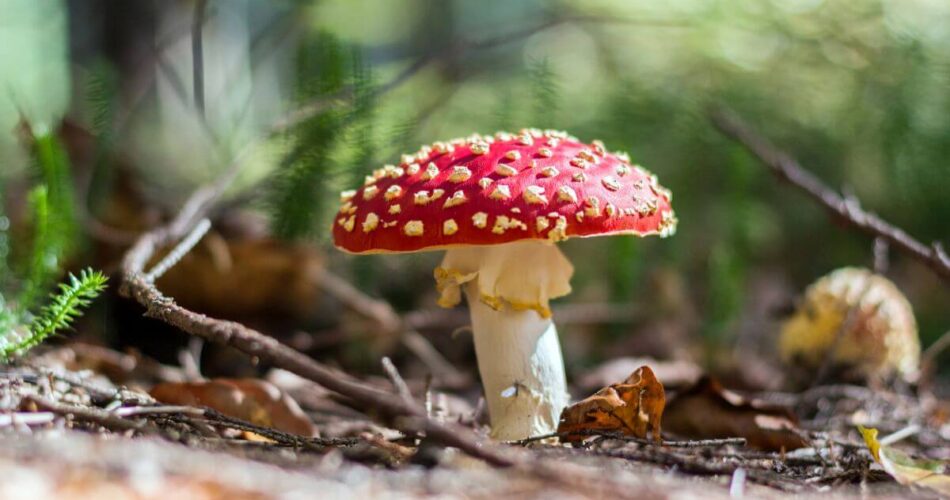The Amanita muscaria is commonly known as the fly agaric or fly amanita. It is one of the most popular poisonous mushrooms in the world. Here’s more information about Amanita Muscaria.
What Is Amanita Muscaria?
Amanita muscaria, also known as the fly agaric or fly amanita, is a mushroom belonging to the genus Amanita. Muscimol in the mushroom is a chemical compound that can cause intense hallucinations and poisoning. These effects can be very disorienting and may last for several hours. The mushroom is native to the Northern parts of the world, but now its distribution is spread among different continents.
Where Does Amanita Muscaria Grow?
This mushroom is found in Europe, Asia, Australia, and North America, so basically it can be found in most of the continents in the world. The Amanita Muscaria is sometimes “dried” and used as an entheogen for its psychoactive properties.
Psychedelic Compounds
Amanita Muscaria is noted for its hallucinogenic properties, with its main psychoactive constituent being the compound muscimol. Muscimol is classified as an iminocyclitol, which places it in a chemical class that also includes compounds like psilocybin and ibotenic acid. Muscimol acts as a potent agonist of the GABA(A) receptor, which is the main inhibitory neurotransmitter in the mammalian central nervous system.
It Was Used as a Hallucinogenic
The Amanita muscaria is a poisonous mushroom that has been used for its psychoactive properties since ancient times. There has been much speculation on possible traditional use of this mushroom as an intoxicant in other places such as the Middle East, Eurasia, North America, and Scandinavia. Some Native American tribes would use it in ceremonies, while others would use it as a hunting tool to intoxicate prey.
Types Of Amanita Muscaria
There are various types of Amanita Muscaria. Below, there are four varieties of this fungus:
- Amanita muscaria: American fly agaric, it has a yellow or orange cap and can be found in Quebec, Southern United States and on the West.
- Amanita muscaria variety muscaria, commonly known as the red-veined fly agaric or European and Asian Amanita muscaria. It has a crimson bright cap and is native to Asia and Northern Europe.
- Amanita muscariavar var. flavivolvata: American fly agaricred, with yellow to yellowish-white warts.
- Amanita muscaria var. inzengae: The fly agaric has a yellow to orange-yellow cap with yellowish warts and a tan stem, which may be pale.
What Does Amanita Muscaria Look Like?
Amanita Muscaria is one of the most popular mushrooms and is often depicted in popular culture.
It is easily recognizable thanks to its bright red cap. Both the cap and the stem are usually 6 inches long. When the mushroom is young, the cap is typically shaped like a dome. However, as the mushroom matures, the cap flattens out and takes on a more umbrella-like shape. Amanita muscaria can be found growing in woods or meadows all across North America and Europe.
The mushroom has a red cap and has white spots and white gills. The color of the cap be different among various species of the mushrooms.
The Properties Of Amanita Muscaria
Being a fungus, it has no chlorophyll and is therefore unable to photosynthesise. Instead, it must feed on organic matter by parasitizing trees or other plants. The fly agaric is mycorrhizal, meaning it forms a symbiotic relationship with the roots of trees. It collects nutrients from decaying organic matter. In return for this food source, the mushroom provides vital mineral salts to the tree roots. In order to thrive, therefore, Amanita muscaria must be kept moist at all times and grown near trees on which to feed. They can be seen in shaded woodland areas close to conifers or broad-leaf trees such as oaks and birches.
Toxicity
Amanita muscaria is a toxic mushroom which contains several toxins that can cause hallucinations. Mushroom poisoning may not be experiences always, but many people do experience gastrointestinal symptoms. The most common symptoms include nausea, vomiting and diarrhea. There are cases of death from this mushroom, but these are usually due to the person eating other Amanita species as well, which contain more toxic compounds.
Toxic Compounds
The toxins in Amanita muscaria are:
- Muscarine: This is a cholinergic compound found in the gills of the mushroom. It causes sweating, salivation and an increased heart rate.
- Muscimol: This is a psychoactive compound found in the cap of the mushroom. It has sedating effects and can cause hallucinations similar to those caused by LSD.
- Ibotenic acid: This is an excitatory compound found in the stem of the mushroom. It causes nausea and vomiting.
Ibotenic acid and muscimol are psychoactive substances that have hallucinogenic properties. All of these toxins consumed in large quantities can be fatal and should be avoided. If you think you have ingested Amanita muscaria, seek medical help immediately.
Symptoms of Intoxication
Symptoms appear after 30 minutes to 1 hour; this time depends on the amount of poison consumed and its concentration. First, there is vomiting, then diarrhea. The most characteristic symptoms include visual and auditory hallucinations (in the form of visions) and a feeling of euphoria, joy. There may be drowsiness or excitement. Later, there are signs of ataxia – staggering gait, loss of coordination, double vision. Speech becomes blurred, the pupils dilated, breathing and heartbeat deepened. Sometimes a state of coma occurs, which can last from a few hours to several days. In some cases, delirium tremens occurs and sudden uncontrollable tremors of the body and limbs.
Not All Symptoms of Poisoning Are the Same for Everyone
The symptoms of poisoning with Amanita muscaria are not always the same. And some people may experience no symptoms at all. The Amanita phalloides, (death cap) is the most dangerous of this genus, and often the most deadly. Although everyone can experience the poisoning slightly different, Amanita muscaria tend to affect the central nervous system, causing a broad range of symptoms from drowsiness to seizures.
Treatment
Treating Amanita muscaria poisoning calls for a hospital stay and the use of powerful antifungal drugs. But there are some natural alternatives that can ease the process and help you get better faster. Treatment comes in two stages: preventing further absorption of the poison by rehydration and treating the symptoms with anticonvulsant or antihistamines that reduce inflammation and help restore electrolyte balance. The treatment consists in keeping the patient under observation, giving him plenty of water to drink, and administering drugs to induce vomiting, if necessary. In the more severe forms of poisoning, there is danger of death from heart failure. No specific medication has been found effective against the poison.
Amanita Muscaria Can Be Very Dangerous
Some people eat Amanita muscaria, or fly agaric mushrooms, believing they will get high and that the experience will be fun. Unfortunately, this is not the case. The effects of eating Amanita muscaria can be extremely unpleasant, and can range from mild to severe intoxication.
Is Amantia Muscaria Legal?
Fly agarics is a mushroom that, when ingested, can induce a psychedelic experience known as “magic mushrooms“. The effects vary from person to person, but all people who have taken them will agree that they are among the most powerful psychedelic drugs.Amanita muscaria’s legality depends on where you live, as laws vary from country to country and in some states it may be against the law. In the US, possession, sales, cultivation is legal in most states, but laws may vary. Except for ornamental purposes, cultivating, selling or possessing Amanita muscaria in Louisiana is illegal under State Act 159. It is also legal in Sweden, Ireland, Ukraine and Mexico.
Illegal Status
In the Netherlands, Australia or Thailand selling, possessing, transporting and cultivation is not legal. Even though it may be legal to possess this type of fungi, it does not mean that it is legal to use it as a drug or should be taken lightly. There are numerous risk associated with these fungi, and it should not be taken without professional help or consumed in any way.This is it shroom lovers, thanks for reading and see you soon!
Similar Posts:
- Amanita Pantherina, Known as Panther Cap – Features, Origin, Toxicity, and More
- Are Mushrooms Legal in Jamaica? Different Types of Shrooms
- Amanita Gemmata: A Tricky Mushroom Worth Discovering
- Psilocybe Muliercula: Discover a Rare and Potent Magic Mushroom
- Gymnopilus Viridans: Uncommon Shrooms Species
- Panaeolus Cyanescens AKA Copelandia Cyanescens: Magic Mushroom
- The Properties of Shrooms and Weed: All You Should Know About Magic Mushrooms and Cannabis






